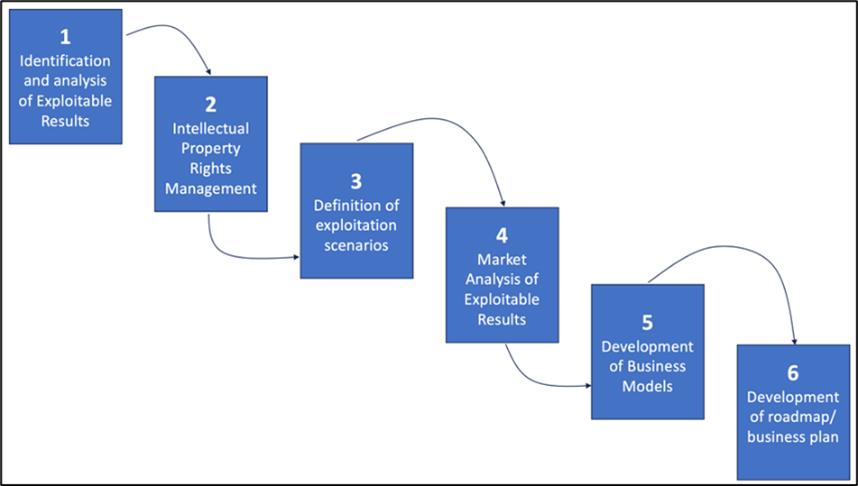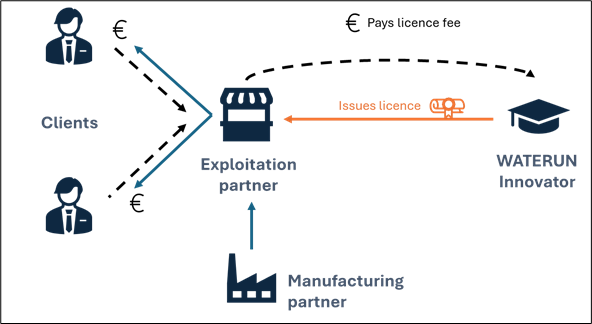The launch of the Horizon Europe program in 2021 marks a significant evolution in EU research and innovation initiatives. In comparison to its predecessor, Horizon Europe places greater importance on exploiting research and innovation outcomes through "Key Impact Pathways," aiming at the amplification of the breadth of EU funding's impact on science, the economy, and society. This incentivizes project consortiums like the team of WATERUN partners to think hard about the promotion and acceleration of the market takeup of corresponding research and innovation outputs like for example the WATERUN solutions. One of the key vehicles to conceptualize these “pathways to impact” consists of the efforts revolving around the exploitation of results. Exploitation in this context can be defined as the use of results including - among other things - commercial exploitation activities such as developing, creating, manufacturing, and marketing a product or process as well as creating and providing a service on a commercial basis.

Figure 1 Methodological Steps for Results Exploitation
An integrated exploitation strategy
WATERUN aims at an integrated exploitation strategy of project results considering the commercialization of products and services to address emerging market needs. Put in simpler terms, the main goal of exploitation within the WATERUN project is to maximize value from the results, in a way that they are distributed and used by decision-makers and practitioners in charge of planning and managing integrated urban water systems even beyond the project scope and timeframe.
Work Package 6 aims at supporting WATERUN innovators to transform their research outcomes into practical applications that can be implemented, shared, and scaled through associated business models. Practically speaking, the exploitation efforts focus on creating business cases of the projects’ exploitable results, so WATERUN project partners or interested third parties can consider future key aspects such as market entry strategies, value capture mechanisms, etc. already during early stages of research and development.
Interdisciplinary challenges
Considering key aspects of commercialization processes already during early phases of research and development can add complexity and new layers of interdisciplinarity to the work of the WATERUN innovators. Seecon is tasked to facilitate this process for and with their project partners making sure that key considerations for exploitation of results can be integrated during the different development stages of the WATERUN innovations. 6 key steps are implemented to achieve this:
Step 1: Identification and Preliminary Analysis of Exploitable Results. In order to translate the academic work plan into a format that allows for an analysis through the lens of marketability, a process is facilitated to describe the key exploitable results in terms of their value proposition, characteristics, potential benefits and end users.
Step 2: Intellectual Property Rights Management. Once key exploitable results are analysed and described adequately, WATERUN partners are engaged in a process to identify potential IPR management issues related to exploitation. Concretely, this process aims at making sure that no fundamental IPR issues will become a barrier to successful exploitation.
Step 3: Definition of exploitation scenarios. Considering potential IPR management issues, generic exploitation scenarios are discussed, analysed and tailored to the strategic goals and organizational capacities of each WATERUN Innovator. The exploitation scenarios outline the institutional set-up for the eventual market uptake of the WATERUN solutions.
Step 4: Market Analysis for Exploitable Results. Once the most adequate exploitation scenarios are identified, a market study is conducted to understand supply, demand and corresponding trends related to the WATERUN Solutions.

Figure 2 Generic Exploitation Scenario: Licensing Agreement
Step 5: Development of Business Models. The results of the market study represent a key input for the subsequent business modelling activities. These aim at clarifying questions related to market positioning, operations, cost structure and revenue streams corresponding to the commercialization strategy for the WATERUN Solutions.
Step 6: Business Plan/Roadmap Development. Once the business model is designed, WATERUN Innovators are tasked to outline a roadmap that establish the steps required to implement said model.
The WATERUN Impact Pathways
Horizon Europe has set a high bar for innovators and the ambitions related to the exploitation of project results are not easily met. The exploitation activities carried out in the framework of work Package 6 of the WATERUN project aim at guiding the WATERUN Innovators in integrating considerations related to future commercial results exploitation into their present research and development efforts. By doing so, WATERUN is set to open the pathways to impact that a water sensitive future demands.
Find out more on: https://www.waterun.eu/
Authors: Simon Joncourt, seecon gmbh, simon.joncourt@seecon.ch